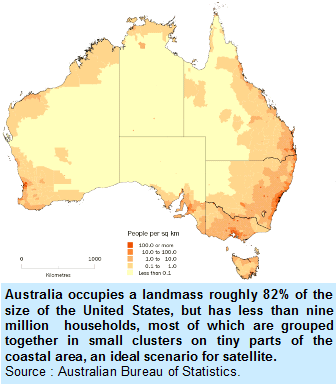Broadband for the Bush
by Elisabeth Tweedie, Associate Editor
Los Angeles, Calif., March 6, 2012-- After more than four years of discussion, debate and deliberation in February of this year the Australian government’s NBN Co. Ltd. signed a contract for two Ka-Band satellites to deliver broadband to the three percent of Australian households and enterprises that are located out of the reach of fiber and terrestrial wireless. This was a landmark decision both for Australia and for the satellite industry as a whole as it marks the first time that a government has so wholeheartedly endorsed satellite as a means of providing broadband connectivity; something that last year the UN in its Broadband Challenge declared to be a “human right”.
Australia occupies a landmass roughly 82% of the size of the United States, but has less than nine million households, most of which are grouped together in small clusters on tiny parts of the coastal area, an ideal scenario for satellite.
NBN Co Ltd. is wholly owned by the Australian government and was established in 2009 with a charter to build and operate a national broadband network. In its corporate plan it has stated that 13 million premises will be served by 2021. It will operate the network on a wholesale basis selling capacity to retail service providers on a non-discriminatory basis. 93% of homes and premises are to be connected by fiber which will provide speeds of up to 1Gbps down and 400Mbps up. 4% will be connected via terrestrial wireless and the remaining three percent by satellite. Wireless and satellite will deliver 12Mbps down and 1Mbps up. The total cost for the network is expected to be in the region of A$ 36 Billion. Last year Ericsson was awarded a contract worth around A$ 1.1 Billion to design, build and operate a LTE network.
 The satellite contract went to Space Systems/Loral (SS/L) and is reported to be worth over US$ 600 million. This is for two 70Gbps Ka-band satellites to be launched within six months of each other in 2015. Loral will also provide TT&C for the first five years and in-orbit support for the life of the satellites.
The satellite contract went to Space Systems/Loral (SS/L) and is reported to be worth over US$ 600 million. This is for two 70Gbps Ka-band satellites to be launched within six months of each other in 2015. Loral will also provide TT&C for the first five years and in-orbit support for the life of the satellites.
As would be expected with a government project of this magnitude the satellite contract has attracted a lot of criticism with much of it coming from the opposition party. The main criticism has been that this capacity is in excess of what is required “the Rolls Royce solution” and the needs of rural Australians could be best served by leasing capacity on existing satellites. An interesting argument given that NBN has stated that it is already leasing as much capacity as it can get (from Optus and iPStar) but can only provide a 6Mbps service to 50,000 end users. It would seem to me that a more relevant question would be why would rural users be content with 12Mbps when their urban cousins will have the option for a much faster service?
The answer of course being that they may well not be! This however bodes well for satellites. The two satellites are required to deliver “initial peak speeds” of 12/1Mbps. The Eutelsat satellite, KA-SAT, also a 70Gbps satellite, was reputedly designed to deliver 10Mbps down and this is the standard speed offered, however official presentations from Eutelsat have talked about delivering 50Mbps down and 20Mbps up. There is no reason to assume that the satellites from SS/L will be any less capable. It just means that as demand for higher bandwidth materializes, the number of users that can be served decreases, if the demand for bandwidth gets so high that the satellites are maxed out then the obvious solution would be another satellite. However given the relatively small number of potential users this isn’t likely to happen in the near future.
Unfortunately no discussion of High Throughput Satellites (HTS) and SS/L can fail to omit a mention the lawsuit filed by ViaSat against the company. SS/L and ViaSat are two highly reputable and well-regarded companies in the satellite industry. It is hard to imagine that SS/L, a company that employs some of the finest engineers in the business, would have knowingly infringed ViaSat’s intellectual property or violated WildBlue’s patents. It’s equally hard to imagine that ViaSat would have filed a frivolous lawsuit.
IF this goes to court (at the time of writing the companies were in discussions) and ViaSat does succeed in proving that its technology was used by Loral on other High Throughput Satellites, then SS/L could, as ViaSat has requested, be unable to use that technology in the future. Unless of course ViaSat decides to license it, which – if this technology is as fundamental to HTS as ViaSat claim – would effectively put ViaSat in control of the broadband world for satellites. Now that could be a very interesting outcome.
Michael Targoff, CEO of SS/L’s parent company Loral Space and Communications, has been quoted in an interview with Space News that “They (ViaSat) appear to believe that they have invented the wheel with respect to high-throughput broadband satellites. We think the wheel has been around for some time”.
Indeed it wouldn’t be the first time in history that great minds have thought alike. Geoffrey Whittle and Hans von Ohain are both credited with inventing the jet engine; Richard Trevithick and Oliver Evans are independently recognized for inventing the high-pressure steam engine. So it is perfectly feasible that both ViaSat and Loral engineers came up with technology that would significantly improve the throughput of Ka-Band satellites. For the sake of those 500,000 or so Australians outside of the reach of wireless or fiber and for the industry as a whole it is to be hoped that this dispute is settled quickly.
----------------------
 Elisabeth Tweedie is the Associate Editor of Satellite Markets and Research . She has over 20 years experience at the cutting edge of new communication and entertainment technologies. She is the founder and President of Definitive Direction a consultancy that focuses on researching and evaluating the long term potential for new ventures, initiating their development and identifying and developing appropriate alliances. During her 10 years at Hughes Electronics she worked on every acquisition and new business that the company considered during her time there. www.definitivedirection.com. She can be reached at: etweedie@definitivedirection.com
Elisabeth Tweedie is the Associate Editor of Satellite Markets and Research . She has over 20 years experience at the cutting edge of new communication and entertainment technologies. She is the founder and President of Definitive Direction a consultancy that focuses on researching and evaluating the long term potential for new ventures, initiating their development and identifying and developing appropriate alliances. During her 10 years at Hughes Electronics she worked on every acquisition and new business that the company considered during her time there. www.definitivedirection.com. She can be reached at: etweedie@definitivedirection.com





